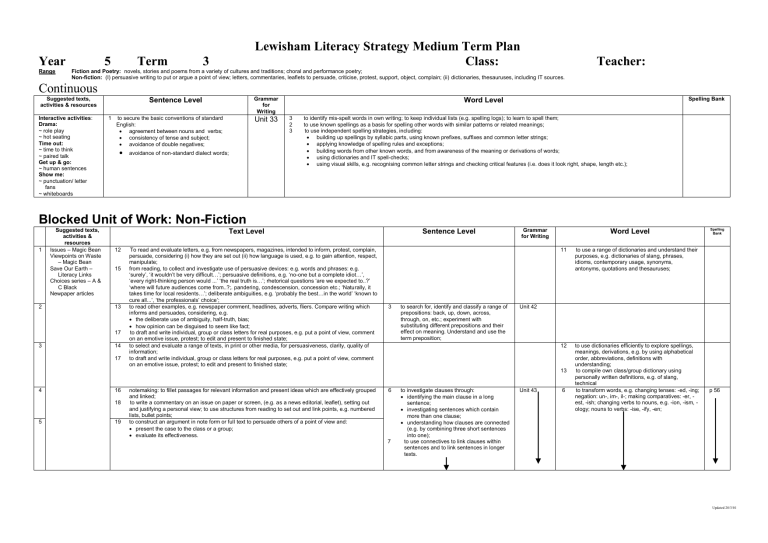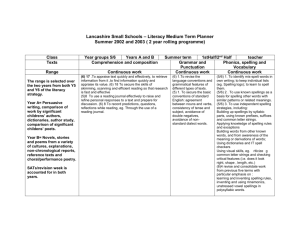Lewisham Literacy Strategy Medium Term Plan

Lewisham Literacy Strategy Medium Term Plan
Year
Range
5 Term 3 Class:
Fiction and Poetry: novels, stories and poems from a variety of cultures and traditions; choral and performance poetry;
Non-fiction: (I) persuasive writing to put or argue a point of view; letters, commentaries, leaflets to persuade, criticise, protest, support, object, complain; (ii) dictionaries, thesauruses, including IT sources.
Teacher:
Continuous
Suggested texts, activities & resources
Interactive activities :
Drama:
~ role play
~ hot seating
Time out:
~ time to think
~ paired talk
Get up & go:
~ human sentences
Show me:
~ punctuation/ letter fans
~ whiteboards
4
5
Sentence Level
1 to secure the basic conventions of standard
English:
agreement between nouns and verbs;
consistency of tense and subject;
avoidance of double negatives;
avoidance of non-standard dialect words;
Grammar for
Writing
Unit 33
Word Level
3 to identify mis-spelt words in own writing; to keep individual lists (e.g. spelling logs); to learn to spell them;
2 to use known spellings as a basis for spelling other words with similar patterns or related meanings;
3 to use independent spelling strategies, including:
building up spellings by syllabic parts, using known prefixes, suffixes and common letter strings;
applying knowledge of spelling rules and exceptions;
building words from other known words, and from awareness of the meaning or derivations of words;
using dictionaries and IT spell-checks;
using visual skills, e.g. recognising common letter strings and checking critical features (i.e. does it look right, shape, length etc.);
Blocked Unit of Work: Non-Fiction
Suggested texts, activities & resources
1 Issues
– Magic Bean
Viewpoints on Waste
– Magic Bean
Save Our Earth
–
Literacy Links
Choices series – A &
C Black
Newpaper articles
2
3
Text Level
12 To read and evaluate letters, e.g. from newspapers, magazines, intended to inform, protest, complain, persuade, considering (i) how they are set out (ii) how language is used, e.g. to gain attention, respect, manipulate;
15 from reading, to collect and investigate use of persuasive devices: e.g. words and phrases: e.g.
‘surely’, ‘it wouldn’t be very difficult…’; persuasive definitions, e.g. ‘no-one but a complete idiot…’,
‘every right-thinking person would ...’ ‘the real truth is…’; rhetorical questions ‘are we expected to..?’
‘where will future audiences come from..?;. pandering, condescension, concession etc.; ‘Naturally, it takes time for local residents…’; deliberate ambiguities, e.g. ‘probably the best…in the world’ ‘known to cure all...’, ‘the professionals’ choice’;
13 to read other examples, e.g. newspaper comment, headlines, adverts, fliers. Compare writing which informs and persuades, considering, e.g.
the deliberate use of ambiguity, half-truth, bias;
how opinion can be disguised to seem like fact;
17 to draft and write individual, group or class letters for real purposes, e.g. put a point of view, comment on an emotive issue, protest; to edit and present to finished state;
14 to select and evaluate a range of texts, in print or other media, for persuasiveness, clarity, quality of information;
17 to draft and write individual, group or class letters for real purposes, e.g. put a point of view, comment on an emotive issue, protest; to edit and present to finished state;
16 notemaking: to fillet passages for relevant information and present ideas which are effectively grouped and linked;
18 to write a commentary on an issue on paper or screen, (e.g. as a news editorial, leaflet), setting out and justifying a personal view; to use structures from reading to set out and link points, e.g. numbered lists, bullet points;
19 to construct an argument in note form or full text to persuade others of a point of view and:
present the case to the class or a group;
evaluate its effectiveness.
Sentence Level
3 to search for, identify and classify a range of prepositions: back, up, down, across, through, on, etc.; experiment with substituting different prepositions and their effect on meaning. Understand and use the term preposition;
6 to investigate clauses through:
identifying the main clause in a long sentence;
investigating sentences which contain
7 more than one clause;
understanding how clauses are connected
(e.g. by combining three short sentences into one); to use connectives to link clauses within sentences and to link sentences in longer texts.
Grammar for Writing
Unit 42
Unit 43
Word Level
Spelling Bank
11 to use a range of dictionaries and understand their purposes, e.g. dictionaries of slang, phrases, idioms, contemporary usage, synonyms, antonyms, quotations and thesauruses;
12 to use dictionaries efficiently to explore spellings, meanings, derivations, e.g. by using alphabetical order, abbreviations, definitions with understanding;
13 to compile own class/group dictionary using personally written definitions, e.g. of slang, technical
6 to transform words, e.g. changing tenses: -ed, -ing; negation: un-, im-, il-; making comparatives: -er, est, -ish; changing verbs to nouns, e.g. -ion, -ism, ology; nouns to verbs: -ise, -ify, -en;
Spelling
Bank p 56
Updated 20/3/01
Lewisham Literacy Strategy Medium Term Plan
Year 5 Term 3
Blocked Unit of Work: Fiction
Suggested texts, activities & resources
1 See Fiction Unit of work
2
Text Level
2 to identify the point of view from which a story is told and how this affects the reader’s response;
10 to write discursively about a novel or story, e.g. to describe, explain, or comment on it;
3 to change point of view, e.g. tell incident or describe a situation from the point of view of another character or perspective;
7 to write from another character’s point of view e.g. retelling an incident in letter form;
Sentence Level
Class:
2 to understand how writing can be adapted for different audiences and purposes, e.g. by changing vocabulary and sentence structures;
Grammar for Writing
Unit 35
3
4
1
8 to investigate a range of texts from different cultures, considering patterns of relationships, social customs, attitudes and beliefs:
identify these features by reference to the text;
consider and evaluate these features in relation to their own experience; to record predictions, questions, reflections while reading, e.g. through the use of a reading journal;
Unit 43
Teacher:
Word Level
4 to spell unstressed vowels in polysyllabic words, e.g. company, portable, poisonous interest description, carpet, sector, freedom, extra, etc.;
8 to identify everyday words such as spaghetti, bungalow, boutique which have been borrowed from other languages, and to understand how this might give clues to spelling;
9 to understand how words vary across dialects, e.g. plimsolls, daps, sand-shoes, pumps;
5
9 to write in the style of the author, e.g. writing on to complete a section, resolve a conflict; writing additional dialogue, new chapter;
6 to explore the challenge and appeal of older literature through:
listening to older literature being read aloud;
reading accessible poems, stories and extracts;
reading extracts from classic serials shown on television;
discussing differences in language used;
10 to write discursively about a novel or story, e.g. to describe, explain, or comment on it;
4 to use punctuation marks accurately in complex sentences;
6 to investigate clauses through:
identifying the main clause in a long sentence;
investigating sentences which contain more than one clause;
understanding how clauses are connected (e.g. by
7 combining three short sentences into one); to use connectives to link clauses within sentences and to link sentences in longer texts.
10 to understand how words can be formed from longer words, e.g. through the omission of letters
– o’clock, Hallowe’en; through omission of prefixes – (omni)bus, (tele)phone,
(aero)plane; through the use of acronyms
– radar, CD;
Blocked Unit of Work: Poetry
Suggested texts, activities & resources
1 Unzip Your Lips – ed.
2
Paul Cookson
Rap with Rosen
–
Michael Rosen
Talking Turkeys
–
Benjamin
Zephaniah
Text Level
4
5 to read, rehearse and modify performance of poetry; to select poetry, justify their choices, e.g. in compiling class anthology;
11 to use performance poems as models to write and to produce poetry in polished forms through revising, redrafting and presentation;
5 to select poetry, justify their choices, e.g. in compiling class anthology;
6 to explore the challenge and appeal of older literature through:
listening to older literature being read aloud;
reading accessible poems, stories and extracts;
reading extracts from classic serials shown on television;
discussing differences in language used;
11 to use performance poems as models to write and to produce poetry in polished forms through revising, redrafting and presentation;
5
Sentence Level to revise use of apostrophes for possession
(from Y4 term 1);
Grammar for
Writing
Unit 27
5
Word Level to investigate and learn spelling rules:
words ending in modifying e drop e when adding ing, e.g. taking;
words ending in modifying e keep e when adding a suffix beginning with a consonant, e.g. hopeful, lovely;
words ending in y preceded by a consonant change y to ie when adding a suffix, e.g. flies, tried
– except for the suffixes ly or ing, e.g. shyly, flying; i before e except after c when the sound is ee, e.g. receive. Note and learn exceptions;
Spelling
Bank p 52
Spelling
Bank p 53 -
55
Updated 20/3/01










